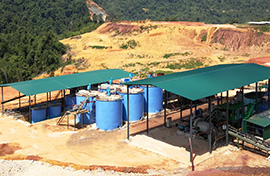-
 E-mail
guhaixin0724@gmail.com
E-mail
guhaixin0724@gmail.com
-
 Call Us
008613683147042
Call Us
008613683147042
 E-mail
guhaixin0724@gmail.com
E-mail
guhaixin0724@gmail.com
 Call Us
008613683147042
Call Us
008613683147042
2020-04-23 Views: 4502
Warm Tip: If you want to know more information, like quotation, products, solutions, etc., please Click here ,and contact us online.

Whether or not flotation can be performed and obtain satisfactory indicators depends largely on the flotation reagent system. In some beneficiation plants that process polymetallic ores or complex refractory ores, the flotation reagent system is a prominent problem in production.
The flotation reagent system mainly includes: the preparation of flotation reagent, the types and dosages of flotation reagent, the order of flotation reagent additions, the adding points and methods of flotation reagent, the time of flotation reagent action, the combination of flotation reagents, the optimal control and adjustment of flotation reagent, etc.
For the same reagent, when the preparation method is different, the dosage and effect are different. The preparation method mainly depends on the characteristic, function and addition method of the flotation reagent.
We have another article that explains in detail the preparation of flotation reagents.
Common preparation methods are:
To formulate better flotation scheme, we should analyze the characteristic of the ore and the possible flotation scheme, and refer to the experience of similar plant.
For example, we should use mixed flotation or priority flotation? What kind of mineral should be floated first? What kind of mineral should be inhibited? What kind of mineral should be activated and so on.
Generally we can refer to the following points:
These experiences are usually feasible, but special circumstances should be treated specially.
Through the above considerations, we can further formulate a plan for the flotation process and propose a prescription for the flotation reagent. The prescription of the flotation reagent includes which kinds of flotation reagent to use and the approximate range of dosage.
When considering these issues, it is important to refer to similar beneficiation plant’s practices. Several sets of process plans and flotation reagent prescriptions should be proposed first, and 1 to 2 should be selected after comparative analysis, and finally determined through tests.
In the process of analysis, test and research, it is necessary to deal with the following contradictions or interactions:
In order to ensure the best concentration of flotation reagent in the slurry, the flotation reagent must be added reasonably. This includes choosing the appropriate dosing sequence, dosing location, dosing method, etc.
Another reason for reasonable addition is that there are usually several kinds of flotation reagents added to the ore pulp, plus the original components in the ore pulp, the interaction between them is very complicated, and they affect and restrict each other.
A good flotation reagent system can make full use of these effects and exert the efficacy of flotation reagents; however, if the flotation reagents are not added properly, it may cause chaos in the entire process.
Reasonable dosing order, dosing location and dosing method should be selected according to ore characteristics, reagent performance, process requirements, etc.
We have another copy that explains this in detail.
Combined flotation reagent means adding two or more flotation reagents of the same type or different types in a certain proportion to improve the effect. It has been widely adopted in practice.
On the one hand, the reason for the better collection effect of mixed flotation reagent may be the unevenness of the surface of the mineral. Different types and characteristics of the reagent can be selectively adsorbed in different intervals or parts to increase the adsorption density of the reagent on the surface of the mineral and the coverage of the reagent, and increase the hydrophobicity of mineral surface.
On the other hand, it may be due to the "co-adsorption" of different reagents on the mineral surface, which enhances the adsorption of the collector on the mineral surface.
The optimization and control of the flotation reagent system in the flotation circuit is critical to the stability of the flotation process and to minimize the reagent consumption. We should understand the relationship between various reagents and minerals in the slurry and the concentration of various reagents, establish a mathematical model under different conditions, and find out the various characteristic parameters and then realized with an automatic control system. This can be achieved mainly through the laboratory and industrial tests.
We’ve talked about flotation reagent in this article. To select the appropriate flotation reagent system, we can refer to the above six points, according to the situation of the plant itself and the practical experience of similar plants, and then choose through the test result.
No. 188, Xinhai Street, high-tech Industrial Park, Fushan District, Yantai, Shandong, China.

Please leave your message here! We will send detail technical info and quotation to you!